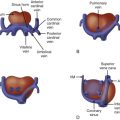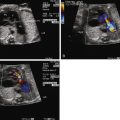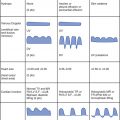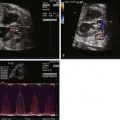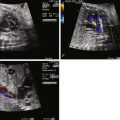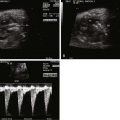- •
Absence of competent aortic valve tissue at the site of the aortic annulus.
- •
Abnormally prominent pulsation of the ascending aorta.
- •
Abnormal dilation of the ascending aorta and/or head brachiocephalic vessels.
- •
Associated anomalies such as aortic arch obstruction and ventricular septal defect.
- •
Ventricular dysfunction.
Anatomy and Anatomical Associations
Congenital absence of the aortic valve leaflets is an extremely rare anomaly, with perhaps no more than two dozen reports in the literature. Absence, or dysplasia, of the pulmonic leaflets is much more common and is seen with tetralogy of Fallot. In most instances of absent aortic valve leaflets, the only remnant of the aortic valve is a nonobstructive fibrous ridge.
Absence of the aortic valve leaflets is typically not an isolated lesion. It is associated with conotruncal anomalies, ventricular septal defect, hypoplasia of the left ventricle, and dysplasia or aplasia of leaflets of the other semilunar, the pulmonic valve. Absence of the aortic valve leaflets was first described in association with double-outlet right ventricle in a pathology specimen. In a review of 15 cases of this anomaly, hypoplasia of the left heart was seen in 11 (73%), double-outlet right ventricle in 5 (33%), and aortic arch malformations in 6 (40%).
Frequency, Genetics, and Development
Absence of the aortic valve leaflets is extremely rare. It is commonly associated with cystic hygroma, which may offer clues to the origin of this rare anomaly. The relatively frequent association between absence of both the aortic and the semilunar valve leaflets has led some investigators to conclude that aplasia of the semilunar valve leaflets reflects an underdevelopment of the endocardial cushion swellings at the ventriculoarterial junction, rather than resulting primarily from an abnormality of septation of the outflow tracts.
In one report, all seven cases were male, which suggests an X-linked process. DiGeorge’s syndrome has been reported in one case.
Prenatal Physiology
Absence of a competent aortic valve results in severe aortic insufficiency. Severe aortic insufficiency affects the fetal circulation in a number of ways. In diastole, blood regurgitates back into the ventricle, which leads to a “steal” of blood flow away from the body organs and tissues. The heart dilates due to the volume load. Cardiomegaly and ventricular dysfunction ensue. Heart failure and fetal hydrops are common. Placental insufficiency can occur as blood is diverted away during diastole. Survival under such conditions is unusual. Most fetuses with this anomaly succumb with fetal demise early in the first weeks of gestation, which may explain the rare nature of the anomaly.
Interestingly, the association with other anomalies may be protective. When seen with hypoplasia of the left ventricle, a stiff left ventricle with elevated end-diastolic pressure may limit the volume of regurgitation across the aortic valve, reducing the physiological effect of a perfusion steal.
We recently saw a fetal case of absent aortic valve with ventricular septal defect and interruption of the aortic arch type C (interruption between the right subclavian artery and the left common carotid artery). Owing to the arch interruption, only the right arm and right common carotid were exposed to the deleterious physiological effects of severe aortic insufficiency because the remainder of the circulation was perfused by the right ventricle through the patent ductus arteriosus and a competent, normal pulmonary valve. This fetus survived to term and suffered sudden fetal demise at 38 weeks’ gestation. We suspect that coronary insufficiency likely played a role in the fetal demise. As the left ventricle continued to dilate, there was a mismatch between coronary perfusion and myocardial demand, leading to myocardial ischemia and sudden death.
Prenatal Management
Absent aortic valve leaflets is essentially a lethal anomaly. The only reports of survival have been in association with hypoplasia of the left ventricle, in which the aorta is small. In such cases, the degree of aortic insufficiency is not of great significance and may not seriously affect coronary perfusion. The essential aspect of prenatal management is making the correct diagnosis.
The fetal findings of absent aortic valve leaflets were first described in 1984 upon identification of pandiastolic reversal of flow in the descending aorta. Today, direct inspection of the left ventricular outflow tract and ascending aorta will reveal absence of the thin normal leaflets of the aortic valve. The ascending aorta may be dilated as it receives an increased stroke volume with each beat. Prominent pulsations of the ascending and descending aorta are typical clues to the presence of this anomaly.
Color Doppler flow imaging will demonstrate severe aortic insufficiency with a wide jet of color flow returning into the left ventricle during diastole. This should be carefully distinguished from inflow across the mitral valve by appropriate angulation of the transducer. Pulse Doppler will demonstrate reversal of flow in the aorta. The more severe the aortic insufficiency, the more distal in the aorta the reversal will be seen. Diastolic reversal in the descending aorta is to be expected, with reversal in the umbilical artery an ominous sign and a substrate for likely fetal demise.
Associated anomalies such as absent pulmonary valve leaflets, conotruncal defects, and arch defects should be looked for. Karyotype assessment is essential because this rare anomaly may be associated with more pervasive genetic or chromosomal abnormalities.
Stay updated, free articles. Join our Telegram channel

Full access? Get Clinical Tree


